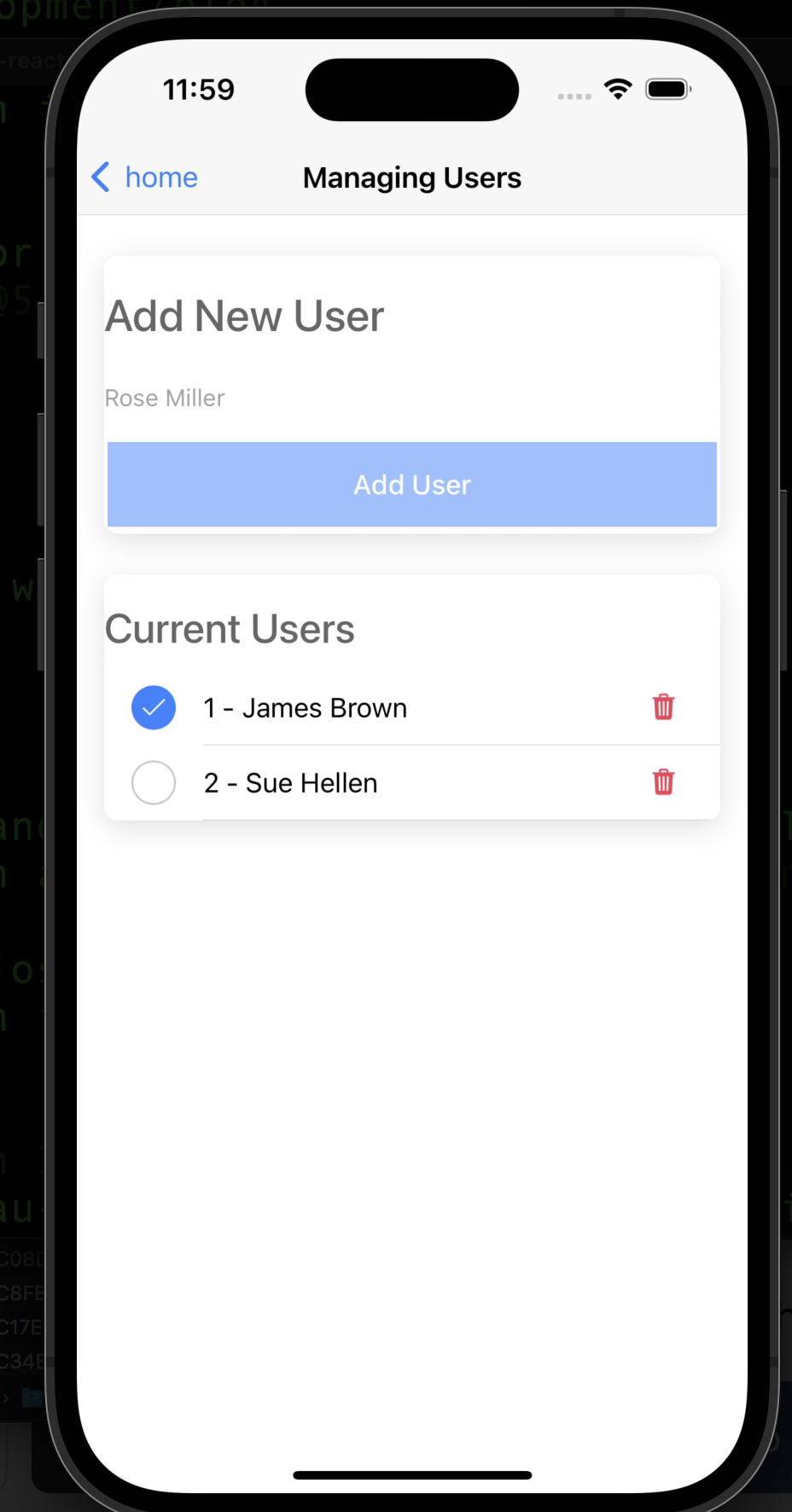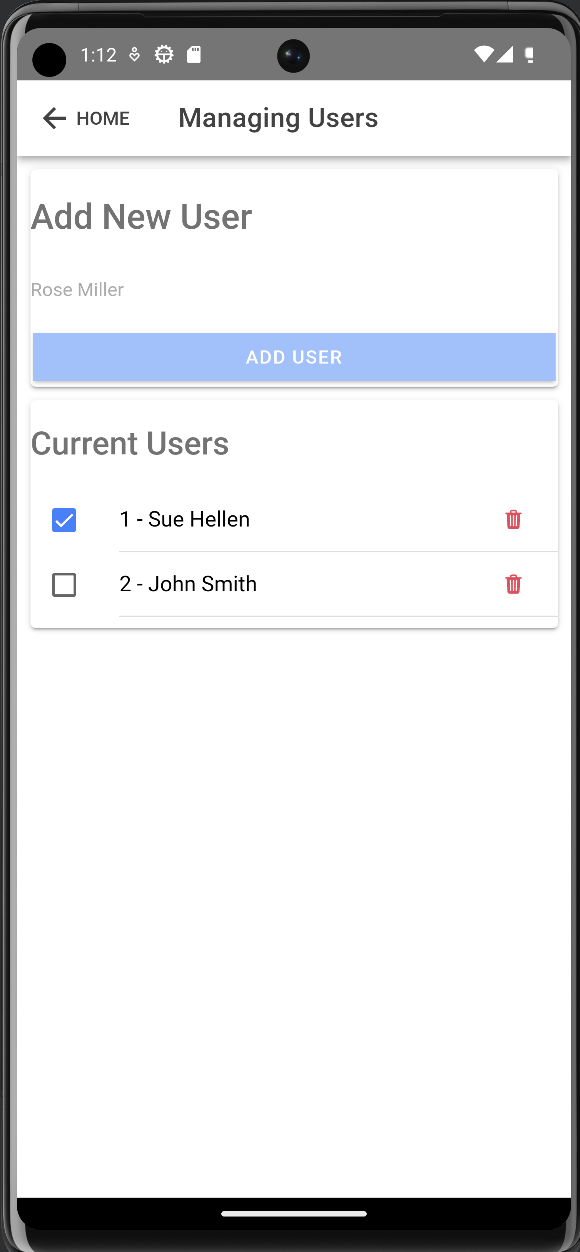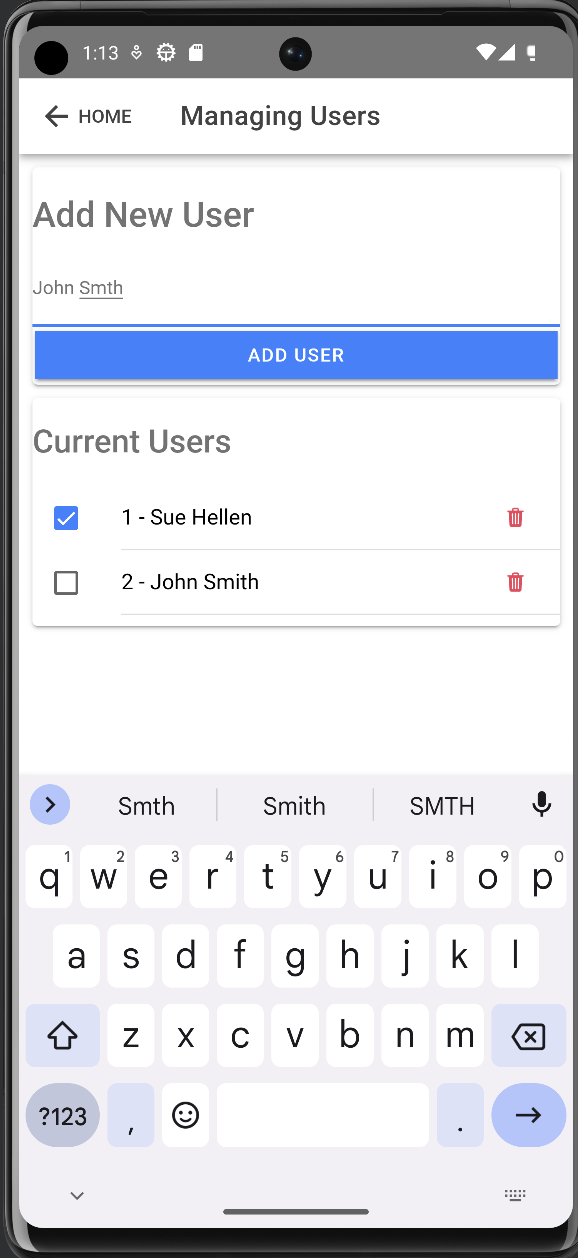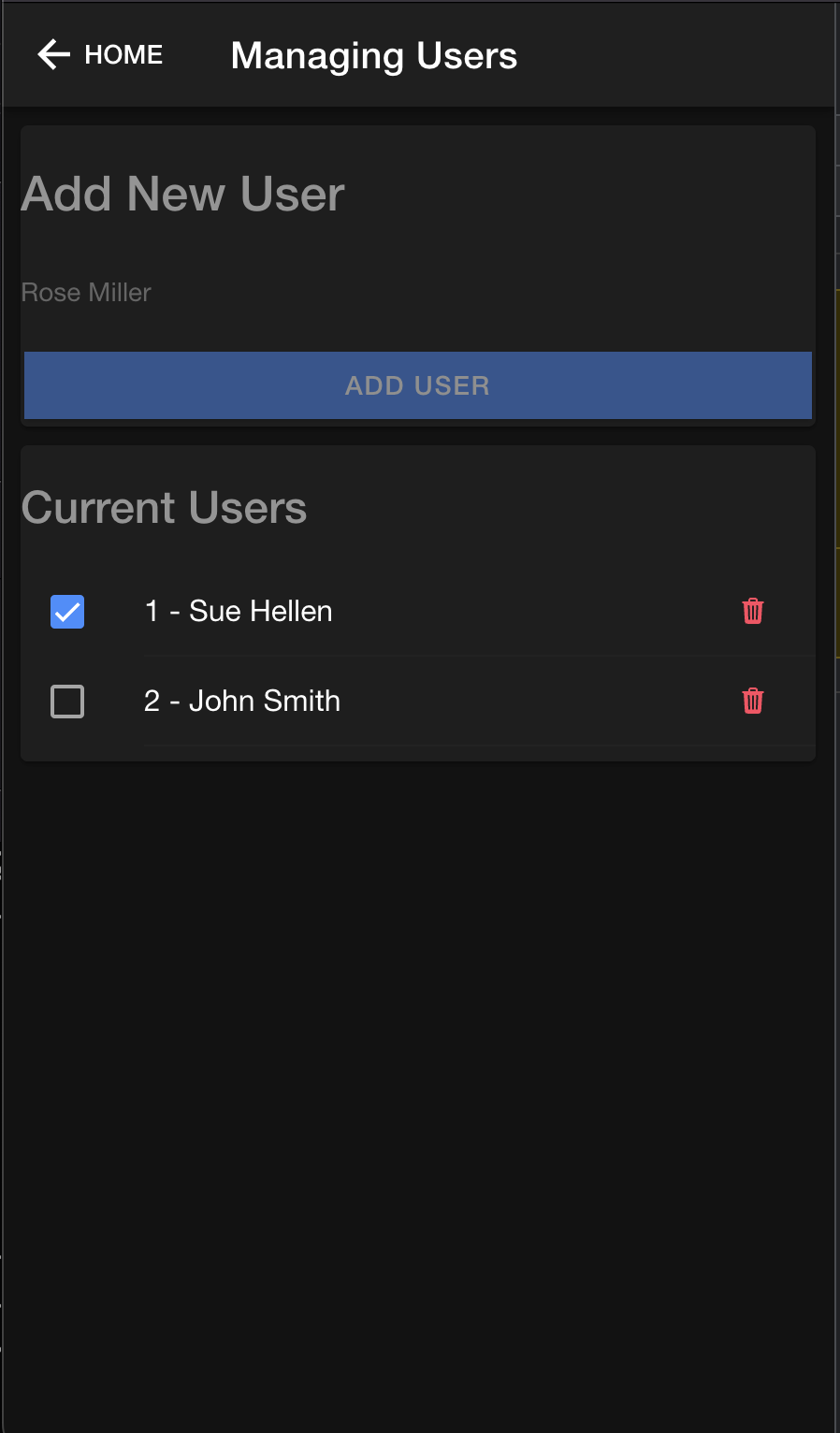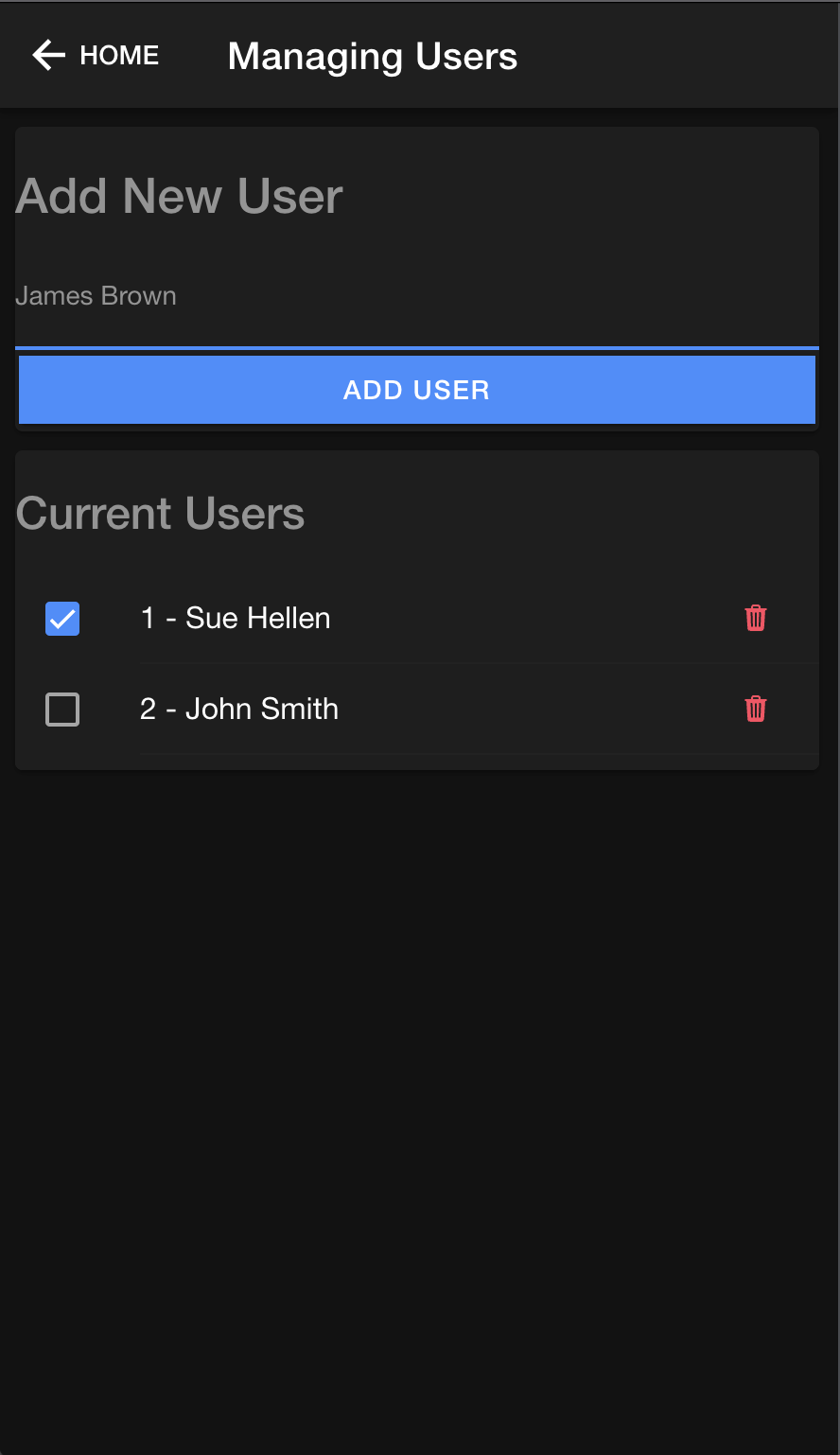Ionic 7 SQLite Database CRUD App Example Tutorial using Vue3 and @capacitor-community/sqlite
last updated on November 6, 2023 by Quéau Jean Pierre
In that tutorial we will learned how to create a Ionic7/Vue basic CRUD application and implement the @capacitor-community/sqlite plugin to store the data in a SQLite database.
The first part of the tutorial will concentrate on how to create that application and run it on a Web browser where the data will be stored on an Indexed database using sql.js and localForage modules. Go to Part 1 - Web - Table of Contents
The application can be found at Part-1/ionic7-vue-sqlite-app
Thanks to the Ionic Team and their hard work to bring CAPACITOR 5, the second part will concentrate on native platforms (iOS and Android) and also on Electron platform. Go to Part 2 - Native - Table of Contents
The application can be found at Part-2/ionic7-vue-sqlite-app
Part 1 - Web - Table of Contents
- Install New Ionic Application
- Install Required Packages
- Create the SQLite Database
- Create CRUD and SQLite Services
- Vue Plugin Implementation
- Users Page Implementation
- Users Component Implementation
- Modify the Home Page
- Add a Menu to the App
- Update Config and Package.json Scripts
- Run the Web SQLite App
- Part 1 Conclusion
Install New Ionic Application
-
Install the latest version of Ionic CLI globally installed on your device, run the below command.
sudo npm install -g @ionic/cli -
Create a new blank Ionic Vue app
ionic start ionic7-vue-sqlite-app blank --type=vue --capacitor -
Go inside the project folder
cd ./ionic7-vue-sqlite-app
Install Required Packages
-
run the below commands
npm install --save @capacitor-community/sqlite npm install --save @capacitor/toast npm install --save @ionic/pwa-elements npm install --save-dev copyfiles
Create the SQLite Database
-
To easily upgrade the database from one version to the next, the database is created through an upgrade statement. In your editor, create a folder
upgradesunder thesrcfolder and then create a new fileupgrades/user.upgrade.statements.ts. -
Define the upgrade statements in
upgrades/user.upgrade.statements.tsfileexport const UserUpgradeStatements = [ { toVersion: 1, statements: [ `CREATE TABLE IF NOT EXISTS users ( id INTEGER PRIMARY KEY AUTOINCREMENT, name TEXT NOT NULL, active INTEGER DEFAULT 1 );` ] }, /* add new statements below for next database version when required*/ /* { toVersion: 2, statements: [ `ALTER TABLE users ADD COLUMN email TEXT;`, ] }, */ ] -
Define the User Model
In your editor, create a folder
modelsunder thesrcfolder and then create a new filemodels/user.ts. -
Update the
models/user.tsfile asexport interface User { id: number name: string active: number /* for version 2 email: string */ }
Create CRUD and SQLite Services
-
To create CRUD and SQLite services, in your file editor, add a new
src/servicesfolder and create the two following files:services/sqliteService.tsservices/storageService.ts
-
Open the
services/sqliteService.tsfile and replace with the following code.import { CapacitorSQLite, SQLiteConnection, SQLiteDBConnection, capSQLiteUpgradeOptions } from '@capacitor-community/sqlite'; import { Capacitor } from '@capacitor/core'; export interface ISQLiteService { getPlatform(): string initWebStore(): Promise<void> addUpgradeStatement(options: capSQLiteUpgradeOptions): Promise<void> openDatabase(dbName: string, loadToVersion: number, readOnly: boolean): Promise<SQLiteDBConnection> closeDatabase(dbName: string, readOnly: boolean): Promise<void> saveToStore(dbName: string): Promise<void> saveToLocalDisk(dbName: string): Promise<void> isConnection(dbName: string, readOnly: boolean): Promise<boolean> }; class SQLiteService implements ISQLiteService { platform = Capacitor.getPlatform(); sqlitePlugin = CapacitorSQLite; sqliteConnection = new SQLiteConnection(CapacitorSQLite); dbNameVersionDict: Map<string, number> = new Map(); getPlatform(): string { return this.platform; } async initWebStore() : Promise<void> { try { await this.sqliteConnection.initWebStore(); } catch(error: any) { const msg = error.message ? error.message : error; throw new Error(`sqliteService.initWebStore: ${msg}`); } return; } async addUpgradeStatement(options: capSQLiteUpgradeOptions): Promise<void> { try { await this.sqlitePlugin.addUpgradeStatement(options); } catch(error: any) { const msg = error.message ? error.message : error; throw new Error(`sqliteService.addUpgradeStatement: ${msg}`); } return; } async openDatabase(dbName:string, loadToVersion: number, readOnly: boolean): Promise<SQLiteDBConnection> { this.dbNameVersionDict.set(dbName, loadToVersion); let encrypted = false; const mode = encrypted ? "secret" : "no-encryption"; try { let db: SQLiteDBConnection; const retCC = (await this.sqliteConnection.checkConnectionsConsistency()).result; let isConn = (await this.sqliteConnection.isConnection(dbName, readOnly)).result; if(retCC && isConn) { db = await this.sqliteConnection.retrieveConnection(dbName, readOnly); } else { db = await this.sqliteConnection .createConnection(dbName, encrypted, mode, loadToVersion, readOnly); } const jeepSQlEL = document.querySelector("jeep-sqlite") await db.open(); const res = await db.isDBOpen(); return db; } catch(error: any) { const msg = error.message ? error.message : error; throw new Error(`sqliteService.openDatabase: ${msg}`); } } async isConnection(dbName:string, readOnly: boolean): Promise<boolean> { try { const isConn = (await this.sqliteConnection.isConnection(dbName, readOnly)).result; if (isConn != undefined) { return isConn } else { throw new Error(`sqliteService.isConnection undefined`); } } catch(error: any) { const msg = error.message ? error.message : error; throw new Error(`sqliteService.isConnection: ${msg}`); } } async closeDatabase(dbName:string, readOnly: boolean):Promise<void> { try { const isConn = (await this.sqliteConnection.isConnection(dbName, readOnly)).result; if(isConn) { await this.sqliteConnection.closeConnection(dbName, readOnly); } return; } catch(error: any) { const msg = error.message ? error.message : error; throw new Error(`sqliteService.closeDatabase: ${msg}`); } } async saveToStore(dbName: string): Promise<void> { try { await this.sqliteConnection.saveToStore(dbName); return; } catch(error: any) { const msg = error.message ? error.message : error; throw new Error(`sqliteService.saveToStore: ${msg}`); } } async saveToLocalDisk(dbName: string): Promise<void> { try { await this.sqliteConnection.saveToLocalDisk(dbName); return; } catch(err:any) { const msg = err.message ? err.message : err; throw new Error(`sqliteService.saveToLocalDisk: ${msg}`); } } } export default new SQLiteService(); -
Open the
services/storage.service.tsand replace the code withimport {platform} from '../App'; import { BehaviorSubject } from 'rxjs'; import {ISQLiteService } from '../services/sqliteService'; import {IDbVersionService } from '../services/dbVersionService'; import { SQLiteDBConnection } from '@capacitor-community/sqlite'; import { UserUpgradeStatements } from '../upgrades/user.upgrade.statements'; import { User } from '../models/User'; export interface IStorageService { initializeDatabase(): Promise<void> getUsers(): Promise<User[]> addUser(user: User): Promise<number> updateUserById(id: string, active: number): Promise<void> deleteUserById(id: string): Promise<void> getDatabaseName(): string getDatabaseVersion(): number }; class StorageService implements IStorageService { versionUpgrades = UserUpgradeStatements; loadToVersion = UserUpgradeStatements[UserUpgradeStatements.length-1].toVersion; db!: SQLiteDBConnection; database: string = 'myuserdb'; sqliteServ!: ISQLiteService; dbVerServ!: IDbVersionService; isInitCompleted = new BehaviorSubject(false); constructor(sqliteService: ISQLiteService, dbVersionService: IDbVersionService) { this.sqliteServ = sqliteService; this.dbVerServ = dbVersionService; } getDatabaseName(): string { return this.database; } getDatabaseVersion(): number { return this.loadToVersion; } async initializeDatabase(): Promise<void> { // create upgrade statements try { await this.sqliteServ.addUpgradeStatement({database: this.database, upgrade: this.versionUpgrades}); this.db = await this.sqliteServ.openDatabase(this.database, this.loadToVersion, false); const isData = await this.db.query("select * from sqlite_sequence"); if(isData.values!.length === 0) { // create database initial users if any } this.dbVerServ.setDbVersion(this.database,this.loadToVersion); if( platform === 'web') { await this.sqliteServ.saveToStore(this.database); } this.isInitCompleted.next(true); } catch(error: any) { const msg = error.message ? error.message : error; throw new Error(`storageService.initializeDatabase: ${msg}`); } } async getUsers(): Promise<User[]> { return (await this.db.query('SELECT * FROM users;')).values as User[]; } async addUser(user: User): Promise<number> { const sql = `INSERT INTO users (name) VALUES (?);`; const res = await this.db.run(sql,[user.name]); if (res.changes !== undefined && res.changes.lastId !== undefined && res.changes.lastId > 0) { return res.changes.lastId; } else { throw new Error(`storageService.addUser: lastId not returned`); } } async updateUserById(id: string, active: number): Promise<void> { const sql = `UPDATE users SET active=${active} WHERE id=${id}`; await this.db.run(sql); } async deleteUserById(id: string): Promise<void> { const sql = `DELETE FROM users WHERE id=${id}`; await this.db.run(sql); } } export default StorageService;
To manage the database versionning, a new service DbnameVersionService is required. In your file editor, go to src/services folder and create the dbVersionService.ts file
-
Open the
services/dbVersionService.tsfile and replace the code withexport interface IDbVersionService { setDbVersion(dbName: string, version: number): void getDbVersion(dbName: string):number| undefined }; class DbVersionService implements IDbVersionService { dbNameVersionDict: Map<string, number> = new Map(); setDbVersion(dbName: string, version: number) { this.dbNameVersionDict.set(dbName, version); }; getDbVersion(dbName: string): number | undefined { const version = this.dbNameVersionDict.get(dbName); return version; }; } export default new DbVersionService();
Vue Plugin Implementation
For Web applications, the plugin uses the Stencil component jeep-sqlite which implies some Vue files modification
-
Open the
main.tsfile and replace the code with the followingimport { createApp } from 'vue' import App from './App.vue' import router from './router'; import { IonicVue } from '@ionic/vue'; /* Core CSS required for Ionic components to work properly */ import '@ionic/vue/css/core.css'; /* Basic CSS for apps built with Ionic */ import '@ionic/vue/css/normalize.css'; import '@ionic/vue/css/structure.css'; import '@ionic/vue/css/typography.css'; /* Optional CSS utils that can be commented out */ import '@ionic/vue/css/padding.css'; import '@ionic/vue/css/float-elements.css'; import '@ionic/vue/css/text-alignment.css'; import '@ionic/vue/css/text-transformation.css'; import '@ionic/vue/css/flex-utils.css'; import '@ionic/vue/css/display.css'; /* Theme variables */ import './theme/variables.css'; import { Capacitor } from '@capacitor/core'; import { JeepSqlite } from 'jeep-sqlite/dist/components/jeep-sqlite'; import { defineCustomElements as pwaElements} from '@ionic/pwa-elements/loader'; import SqliteService from './services/sqliteService'; import DbVersionService from './services/dbVersionService'; import StorageService from './services/storageService'; import InitializeAppService from './services/initializeAppService'; pwaElements(window); customElements.define('jeep-sqlite', JeepSqlite); const platform = Capacitor.getPlatform(); const app = createApp(App) .use(IonicVue) .use(router); // Set the platform as global properties on the app app.config.globalProperties.$platform = platform; // Define and instantiate the required services const sqliteServ = new SqliteService(); const dbVersionServ = new DbVersionService(); const storageServ = new StorageService(sqliteServ, dbVersionServ); // Set the services as global properties on the app app.config.globalProperties.$sqliteServ = sqliteServ; app.config.globalProperties.$dbVersionServ = dbVersionServ; app.config.globalProperties.$storageServ = storageServ; //Define and instantiate the InitializeAppService const initAppServ = new InitializeAppService(sqliteServ, storageServ); const mountApp = () => { initAppServ.initializeApp() .then(() => { router.isReady().then(() => { app.mount('#app'); }); }) .catch((error) => { console.error('App Initialization error:', error); }); } if (platform !== "web") { mountApp(); } else { window.addEventListener('DOMContentLoaded', async () => { const jeepEl = document.createElement("jeep-sqlite"); document.body.appendChild(jeepEl); customElements.whenDefined('jeep-sqlite').then(() => { mountApp(); }) .catch ((err) => { console.error('jeep-sqlite creation error:', err); }); }); }As the goal is to ensure that the services (
SqliteService,DbVersionServiceandStorageService) are unique and properly shared and available throughout the components, they have been set as global properties on the app. -
To initialize the application, an
InitializeAppServiceservice is execute prior mounting the app and has to be created. -
In your Editor add a new file
initializeAppService.tsfile under the foldersrc/services. -
In your editor, open the file
services/initializeAppService.tsand replace the code with:import {ISQLiteService } from '../services/sqliteService'; import {IStorageService } from '../services/storageService'; export interface IInitializeAppService { initializeApp(): Promise<boolean> }; class InitializeAppService implements IInitializeAppService { appInit = false; sqliteServ!: ISQLiteService; storageServ!: IStorageService; platform!: string; constructor(sqliteService: ISQLiteService, storageService: IStorageService) { this.sqliteServ = sqliteService; this.storageServ = storageService; this.platform = this.sqliteServ.getPlatform(); } async initializeApp() : Promise<boolean> { if(!this.appInit) { try { if (this.platform === 'web') { await this.sqliteServ.initWebStore(); } // Initialize the myuserdb database await this.storageServ.initializeDatabase(); if( this.platform === 'web') { await this.sqliteServ.saveToStore(this.storageServ.getDatabaseName()); } this.appInit = true; } catch(error: any) { const msg = error.message ? error.message : error; throw new Error(`initializeAppError.initializeApp: ${msg}`); } } return this.appInit; } } export default InitializeAppService; -
Open the
App.vuefile and replace the code with<template> <ion-app> <ion-router-outlet /> </ion-app> </template> <script setup lang="ts"> import { IonApp, IonRouterOutlet } from '@ionic/vue'; import AppMenu from '@/components/AppMenu.vue'; </script> -
Add a route
/usersin thesrc/router/index.tsfile by adding
import { createRouter, createWebHistory } from '@ionic/vue-router';
import { RouteRecordRaw } from 'vue-router';
import HomePage from '../views/HomePage.vue';
import UsersPage from '../views/UsersPage.vue';
const routes: Array<RouteRecordRaw> = [
{
path: '/',
redirect: '/home'
},
{
path: '/home',
name: 'Home',
component: HomePage
},
{
path: "/users",
name: "Users",
component: UsersPage,
},
]
const router = createRouter({
history: createWebHistory(import.meta.env.BASE_URL),
routes
})
export default router
Users Page Implementation
As you can see above, a route /users to a UsersPage has been added.
Let’s create it.
-
In your Editor, under
src/viewsfolder add a new pageUsersPage.vue. -
Then open the
UsersPage.vuefile and add the following code:<template> <ion-page> <ion-header> <ion-toolbar> <ion-title>Managing Users</ion-title> <ion-buttons slot="start"> <ion-back-button text="home" default-href="/home"></ion-back-button> </ion-buttons> </ion-toolbar> </ion-header> <ion-content> <div v-if="isInitComplete && dbInitialized"> <ion-card> <h1>Add New User</h1> <user-form :onAddUser="handleAddUser" /> </ion-card> <ion-card> <h2>Current Users</h2> <user-list :users="users" :onUpdateUser="handleUpdateUser" :onDeleteUser="handleDeleteUser" /> </ion-card> </div> </ion-content> </ion-page> </template> <script lang="ts"> import { defineComponent, ref, computed, getCurrentInstance, onMounted, onBeforeUnmount, watch, Ref } from 'vue'; import { useIonRouter } from '@ionic/vue'; import { IonPage, IonHeader, IonToolbar, IonButtons, IonBackButton, IonTitle, IonContent, IonCard} from '@ionic/vue'; import { Toast } from '@capacitor/toast'; import { User } from '@/models/User'; import UserForm from '@/components/UserForm.vue'; import UserList from '@/components/UserList.vue'; import { useQuerySQLite } from '@/hooks/UseQuerySQLite'; import { SQLiteDBConnection } from '@capacitor-community/sqlite'; export default defineComponent({ name: 'TestPage', components: { IonPage, IonHeader, IonToolbar, IonButtons, IonBackButton, IonTitle, IonContent, IonCard, UserForm, UserList }, setup() { const dbNameRef = ref(''); const isInitComplete = ref(false); const isDatabase = ref(false); const users = ref<User[]>([]); const db = ref(null); const appInstance = getCurrentInstance(); const router = useIonRouter(); const sqliteServ = appInstance?.appContext.config.globalProperties.$sqliteServ; const storageServ = appInstance?.appContext.config.globalProperties.$storageServ; const dbInitialized = computed(() => !!db.value); const platform = sqliteServ.getPlatform(); const getAllUsers = async (db: Ref<SQLiteDBConnection|null>) => { const stmt = 'SELECT * FROM users'; const values: any[] = []; const fetchData = await useQuerySQLite(db, stmt, values); users.value = fetchData; } const openDatabase = async () => { try { const dbUsersName = storageServ.getDatabaseName(); dbNameRef.value = dbUsersName; const version = storageServ.getDatabaseVersion(); const database = await sqliteServ.openDatabase(dbUsersName, version, false); db.value = database; isDatabase.value = true; } catch (error) { const msg = `Error open database: ${error}`; console.error(msg); Toast.show({ text: msg, duration: 'long' }); } }; const handleAddUser = async (newUser: User) => { if (db.value) { const isConn = await sqliteServ.isConnection(dbNameRef.value, false); const lastId = await storageServ.addUser(newUser); newUser.id = lastId; users.value.push(newUser as never); } }; const handleUpdateUser = async (updUser: User) => { if (db.value) { const isConn = await sqliteServ.isConnection(dbNameRef.value, false); await storageServ.updateUserById(updUser.id.toString(), updUser.active); users.value = users.value.map((user: User) => { if (user.id === updUser.id) { // Clone the user and update the active property return { ...user, active: updUser.active }; } else { return user; } }); } }; const handleDeleteUser = async (userId: number) => { if (db.value) { const isConn = await sqliteServ.isConnection(dbNameRef.value, false); await storageServ.deleteUserById(userId.toString()); users.value = users.value.filter(user => (user as User).id !== userId); } }; onMounted(() => { const initSubscription = storageServ.isInitCompleted.subscribe(async (value: boolean) => { isInitComplete.value = value; if (isInitComplete.value === true) { const dbUsersName = storageServ.getDatabaseName(); if (platform === "web") { customElements.whenDefined('jeep-sqlite').then(async () => { await openDatabase(); }).catch((error) => { const msg = `Error open database: ${error}`; console.log(msg); Toast.show({ text: msg, duration: 'long' }); }); } else { await openDatabase(); } } }); }); onBeforeUnmount(() => { sqliteServ.closeDatabase(dbNameRef.value, false) .then(() => { isDatabase.value = false; }).catch((error: any) => { const msg = `Error close database: ${error.message ? error.message : error}`; console.error(msg); Toast.show({ text: msg, duration: 'long' }); }); }); watch(isDatabase, (newIsDatabase) => { if (newIsDatabase) { getAllUsers(db).then(() => { }) .catch((error: any) => { const msg = `close database: ${error.message ? error.message : error}`; console.error(msg); Toast.show({ text: msg, duration: 'long' }); }); } else { const msg = `newDb is null`; console.error(msg); Toast.show({ text: msg, duration: 'long' }); } }); return {isInitComplete, dbInitialized, users, handleAddUser, handleUpdateUser, handleDeleteUser} }, }); </script>
Users Component Implementation
In that tutorial we use a simple UI interface for CRUD operations through the use of a UserForm and a UserList Vue component.
-
Under
src/componentsfolder create two new filesUserForm.vueandUserList.vue. -
Open the
components/UserForm.vuefile and copy the following code<template> <div class="UserForm"> <ion-input ref="ionNameEl" :value="nameModel" @ionInput="handleNameInput($event)" type="text" placeholder="Rose Miller" ></ion-input> <!-- version 2 <ion-input ref="ionEmailEl" :value="emailModel" @ionInput="handleEmailInput($event)" type="email" placeholder="Email" ></ion-input> --> <ion-button expand="full" @click="handleSubmit" :disabled="!isFormValid"> Add User </ion-button> </div> </template> <script lang="ts"> import { ref } from 'vue'; import { defineComponent, watch } from 'vue'; import { IonInput, IonButton } from '@ionic/vue'; export default defineComponent({ name: 'UserForm', props: { onAddUser: Function, }, components: {IonInput, IonButton}, setup(props) { const ionNameEl = ref(); const nameModel = ref(''); const ionEmailEl = ref(); const emailModel = ref(''); const isFormValid = ref(false); const handleNameInput = (ev: { target: any; }) => { const value = ev.target!.value; const fileterdValue = value.replace(/[^a-zA-Z0-9-' ']+/g, ''); nameModel.value = value; const inputCmp = ionNameEl.value; if (inputCmp !== undefined) { inputCmp.$el.value = fileterdValue; } }; /* Version 2 const handleEmailInput = (ev: { target: any; }) => { const value = ev.target!.value; // Update both the state variable and // the component to keep them in sync. emailModel.value = value; const inputCmp = ionEmailEl.value; if (inputCmp !== null) { inputCmp.$el.value = value; } }; */ const handleSubmit = () => { if (nameModel.value /*&& emailModel.value */) { const newUser = { id: Date.now(), // do not care about the id value (generated by sqlite) name: nameModel.value, active: 1, /* email: emailModel.value, // version 2 */ }; if (typeof props.onAddUser === 'function') { props.onAddUser(newUser); } nameModel.value = ''; /* emailModel.value = ''; // version 2 */ isFormValid.value = false; } }; const hasTwoWords = (input: string) => { const words = input.trim().split(' '); return words.length === 2 && words.every((word) => word !== ''); }; /* Version 2 const isValidEmail = (email) => { if (email.length === 0) { return false; } const emailRegex = /^[a-zA-Z0-9._%+-]+@[a-zA-Z0-9.-]+\.[a-zA-Z]{1,}$/; return emailRegex.test(email); }; */ // Watch 'name' and 'email' for changes and update 'isFormValid' watch([nameModel/*, emailModel*/], ([newName/*, newEmail*/]) => { isFormValid.value = hasTwoWords(newName) /* && isValidEmail(newEmail)*/; }); return { ionNameEl, nameModel, /* emailModel, */ isFormValid, handleNameInput, /*handleEmailInput,*/ handleSubmit, }; }, }); </script> -
Open the
components/UserList.vuefile and copy the following code<template> <ion-list class="UserList"> <ion-item v-for="user in users" :key="user.id"> <ion-checkbox ref="ionActiveEl" slot="start" :checked="user.active==1 ? true: false" :activeModel="user.active" @ionChange="handleCheckboxChange(user)" ></ion-checkbox> - <ion-button slot="end" fill="clear" color="danger" @click="handleDeleteUser(user.id)" > <ion-icon :icon="trash" /> </ion-button> </ion-item> </ion-list> </template> <script lang="ts"> import { defineComponent, ref } from 'vue'; import { IonList, IonItem, IonCheckbox, IonButton, IonIcon, IonLabel } from '@ionic/vue'; import { User } from '@/models/User'; import { trash } from 'ionicons/icons'; export default defineComponent({ name: 'UserList', props: { users: Array as () => User[], onUpdateUser: Function, onDeleteUser: Function }, components: { IonList, IonItem, IonCheckbox, IonButton, IonIcon, IonLabel }, setup(props) { const ionActiveEl = ref(); const handleCheckboxChange = (user: User) => { // Create a new user object with the updated active value const updatedUser = { ...user, active: user.active === 1 ? 0 : 1 }; if (typeof props.onUpdateUser === 'function') { props.onUpdateUser(updatedUser); } }; const handleDeleteUser = (userId: number) => { if (typeof props.onDeleteUser === 'function') { props.onDeleteUser(userId); } } return { handleCheckboxChange, handleDeleteUser, trash }; }, }); </script>!!! Caution Between the </ion-checkbox> <ion-button tags You must read
Double left Curly Bracketuser.idDouble Right Curly Bracket-Double left Curly Bracketuser.nameDouble Right Curly Bracket
Modify the Home Page
The Home page will be modify to include:
- a company logo
- a welcome text
- a menu to access application pages
This will be achieved by creating new Vue components that will be integrated in the Home page and for the menu component in the App.tx file
-
Create an
AppLogoVue component-
In your Editor create a
AppLogo.vuefile undersrc/componentsfolder and copy the following code<template> <div class="AppLogo"> <img src="/assets/JeepQLogo.png" alt="App Logo" width="128" height="128" /> </div> </template> <script lang="ts"> import { defineComponent } from 'vue'; export default defineComponent({ name: 'AppLogo', }); </script> <style scoped> .AppLogo { width: 100%; max-height: 200px; display: flex; justify-content: center; } </style>
Obviously use your own logo and store it in the
public/assetsfolder. -
-
Create an
AppIntroTextVue component-
In your Editor create a
AppIntroText.vuefile undersrc/componentsfolder and copy the following code<template> <div class="AppIntroText"> <h3> Welcome to the Ionic7/Vue SQLite Database CRUD App Example Tutorial </h3> <h4>using @capacitor-community/sqlite</h4> </div> </template> <script lang="ts"> import { defineComponent } from 'vue'; export default defineComponent({ name: 'AppIntroText', }); </script> <style scoped> .AppIntroText { width: 100%; max-height: 200px; display: flex; flex-direction: column; justify-content: center; text-align: center; margin-top: 5%; } </style>
Fill free to put whatever text you would like to see
-
-
Create an
AppMenuButtonVue component-
In your Editor create a
AppMenuButton.vuefile undersrc/componentsfolder and copy the following code<template> <IonMenuButton slot="end" /> </template> <script lang="ts"> import { defineComponent } from 'vue'; import { IonMenuButton} from '@ionic/vue'; export default defineComponent({ name: 'AppMenuButton', components: {IonMenuButton} }); </script>
-
-
Then the
views/HomePage.vuefile can be modified as below to include all these components:<template> <ion-page> <ion-header :translucent="true"> <ion-toolbar> <app-menu-button></app-menu-button> <ion-title>Home</ion-title> </ion-toolbar> </ion-header> <ion-content :fullscreen="true"> <ion-header collapse="condense"> <ion-toolbar> <ion-title size="large">Home</ion-title> </ion-toolbar> </ion-header> <div id="container"> <app-logo></app-logo> <app-intro-text></app-intro-text> </div> </ion-content> </ion-page> </template> <script lang="ts"> import { defineComponent } from 'vue'; import { IonContent, IonHeader, IonPage, IonTitle, IonToolbar } from '@ionic/vue'; import AppLogo from '@/components/AppLogo.vue' import AppIntroText from '@/components/AppIntroText.vue' import AppMenuButton from '@/components/AppMenuButton.vue' export default defineComponent({ name: 'HomePage', components: { IonPage, IonHeader, IonToolbar, IonTitle, IonContent, AppLogo, AppIntroText, AppMenuButton }, setup () { } }); </script> <style scoped> #container { text-align: center; position: relative; top: 10%; left: 0; right: 0; display: flex; flex-direction: column; } </style>
Add a Menu to the App
-
For easy maintenance, the menu is implemented as a Vue component.
- In your Editor create a
AppMenu.vuefile undersrc/componentsfolder and copy the following code
<template> <ion-menu class="AppMenu" side="end" content-id="main-content"> <ion-header> <ion-toolbar> <ion-title>Menu Content</ion-title> </ion-toolbar> </ion-header> <ion-content> <ion-list> <ion-item @click="closeMenu"> <ion-button size="default" router-link="/users" expand="full">Managing Users</ion-button> </ion-item> <!-- ... other menu items --> </ion-list> </ion-content> </ion-menu> </template> <script lang="ts"> import { IonMenu, IonHeader, IonToolbar, IonTitle, IonContent, IonList, IonItem, IonButton } from '@ionic/vue'; import { defineComponent } from 'vue'; import { useIonRouter } from '@ionic/vue'; export default defineComponent({ name: 'AppMenu', components: { IonMenu, IonHeader, IonToolbar, IonTitle, IonContent, IonList, IonItem, IonButton }, setup() { const router = useIonRouter(); const closeMenu = () => { const menu = document.querySelector('ion-menu'); menu!.close(); }; return {closeMenu, router} }, }); </script> <style scoped> .AppMenu ion-button { --background: transparent; --color: initial; font-size: 18px; } </style> - In your Editor create a
-
Then modify the
App.vuefile-
by adding
import AppMenu from './components/AppMenu/AppMenu'; -
replace
<ion-router-outlet />with<app-menu /> <ion-router-outlet id="main-content"/>
-
Update Config and Package.json Scripts
-
For Web application only the appID of the
capacitor.config.tsmust be amended withYOUR_APP_ID - For the
package .jsonfile-
add the following script below
"build": "tsc && vite build",,"build:web": "npm run copy:sql:wasm && vue-tsc && vite build", "ionic:serve:before": "npm run copy:sql:wasm", "copy:sql:wasm": "copyfiles -u 3 node_modules/sql.js/dist/sql-wasm.wasm public/assets", -
modify the
"dev": "vite",with"dev": "npm run copy:sql:wasm && vite",
-
-
For the
vite.config.tsfile to reduce the size of the chunks after minification add the following lines after thepluginsblockbuild: { rollupOptions: { output:{ manualChunks(id) { if (id.includes('node_modules')) { return id.toString().split('node_modules/')[1].split('/')[0].toString(); } } } } },
Run the Web SQLite App
-
To run the Web app use the below command
npm run dev -
In your favorite Browser enter
http://localhost:5173/ -
This will bring you to the
Homepage
-
To open the menu, click on the
icon in the top left corner. 
-
In the
Menu Contentclick onMANAGING USERS
On the screen-copy, ones has entered already some users.
- To input new users
- type a new user on the input field “Rose Miller” under Name
- press on the
"Add User"button will add the user.
-
To update the
activevalue for a user, press on the check icon on the left it will toggle the value from 1 to 0 or from 0 to 1. -
To delete a user press on the
trashicon. - To save the database to store leave the
UsersPageby going backHome.
The database location can be see in the application tab of the development tools.
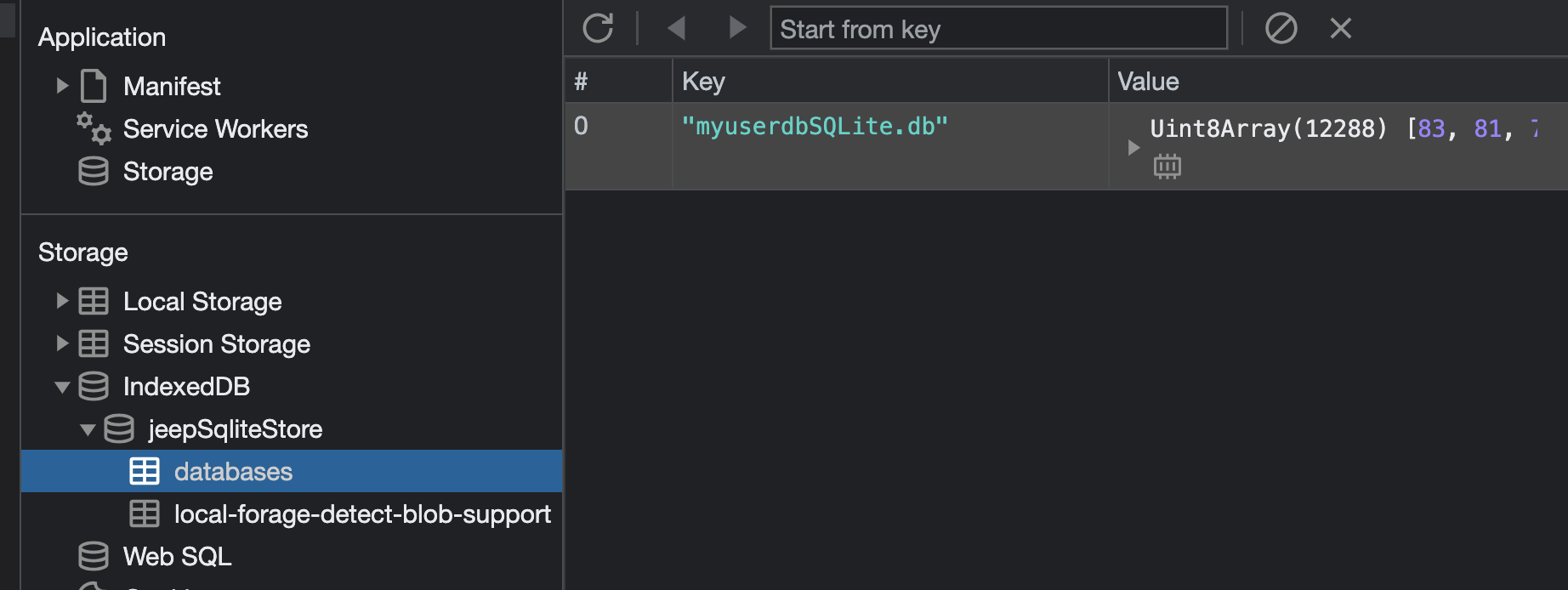
Part 1 Conclusion
We have completed the Part 1 - Web application of the Ionic 7 SQLite Database CRUD App Example Tutorial using Vue and @capacitor-community/sqlite.
We learned how to implement the ‘@capacitor-community/sqlite’ plugin in the Vue Framework using standalone components on a Web platform.
We learned to use app.config.globalProperties to ensure that the services are available to all components within the app.
We learned how to create an application menu.
We learned how to used some basic methods of the ‘@capacitor-community/sqlite’ plugin to create a CRUD application from scratched and store persistent SQLite data into the Web IndexedDB browser database.
Enjoy your development from there.
Part 2 - Native - Table of Contents
- Install Native Required Packages
- Update Config file
- Update Package.json Scripts
- Run the iOS App
- Run the Android App
- Run the Electron App
- Part 2 Conclusion
Install Native Required Packages
-
In order to build Android, iOS, or Electron applications on specific devices, it is necessary to install the necessary capacitor packages first. So run the following commands:
npm install --save @capacitor/android npm install --save @capacitor/ios npm install --save @capacitor-community/electron -
Integrate the various platforms into the application.
npm run build npx cap add android npx cap add ios npx cap add @capacitor-community/electron
Update Config file
The capacitor.config.ts file specifies parameters that the plugin needs, such as database location, database encryption, and the use of biometric authentication for access security. Such settings may be platform specific.
-
Please modify the
capacitor.config.tsfile as below :import { CapacitorConfig } from '@capacitor/cli'; const config: CapacitorConfig = { appId: 'YOUR_APP_ID', appName: 'YOUR_APP_NAME', webDir: 'dist', loggingBehavior: 'debug', server: { androidScheme: "http" }, plugins: { CapacitorSQLite: { iosDatabaseLocation: 'Library/CapacitorDatabase', iosIsEncryption: false, iosKeychainPrefix: 'YOUR_APP_NAME', iosBiometric: { biometricAuth: false, biometricTitle : "Biometric login for capacitor sqlite" }, androidIsEncryption: false, androidBiometric: { biometricAuth : false, biometricTitle : "Biometric login for capacitor sqlite", biometricSubTitle : "Log in using your biometric" }, electronIsEncryption: false, electronWindowsLocation: "C:\\ProgramData\\CapacitorDatabases", electronMacLocation: "/Users/YOUR_NAME/CapacitorDatabases", electronLinuxLocation: "Databases" } } }; export default config;
Update Package.json Scripts
-
First install a new package to remove the sql.js wasm file to reduce the native package size
npm install --save-dev rimraf -
Open the
package.jsonfile and replace the scripts section with:"scripts": { "dev": "npm run copy:sql:wasm && vite", "build:web": "npm run copy:sql:wasm && npm run build", "build:native": "npm run remove:sql:wasm && npm run build", "build": "vue-tsc && vite build", "preview": "vite preview", "ionic:serve:before": "npm run copy:sql:wasm", "copy:sql:wasm": "copyfiles -u 3 node_modules/sql.js/dist/sql-wasm.wasm public/assets", "remove:sql:wasm": "rimraf public/assets/sql-wasm.wasm", "ios:start": "npm run remove:sql:wasm && npm run build:native && npx cap sync && npx cap copy && npx cap open ios", "android:start": "npm run remove:sql:wasm && npm run build:native && npx cap sync && npx cap copy && npx cap open android", "electron:install": "cd electron && npm install && cd ..", "electron:prepare": "npm run remove:sql:wasm && npm run build && npx cap sync @capacitor-community/electron && npx cap copy @capacitor-community/electron", "electron:start": "npm run electron:prepare && cd electron && npm run electron:start", "clean:vite:cache": "vite clean", "test:e2e": "cypress run", "test:unit": "vitest", "lint": "eslint" },
Run the iOS App
-
Run the following command:
npm run ios:start -
In Xcode wait for indexed file to complete, clean the project and run the app. You will get the following screen for the Home Page
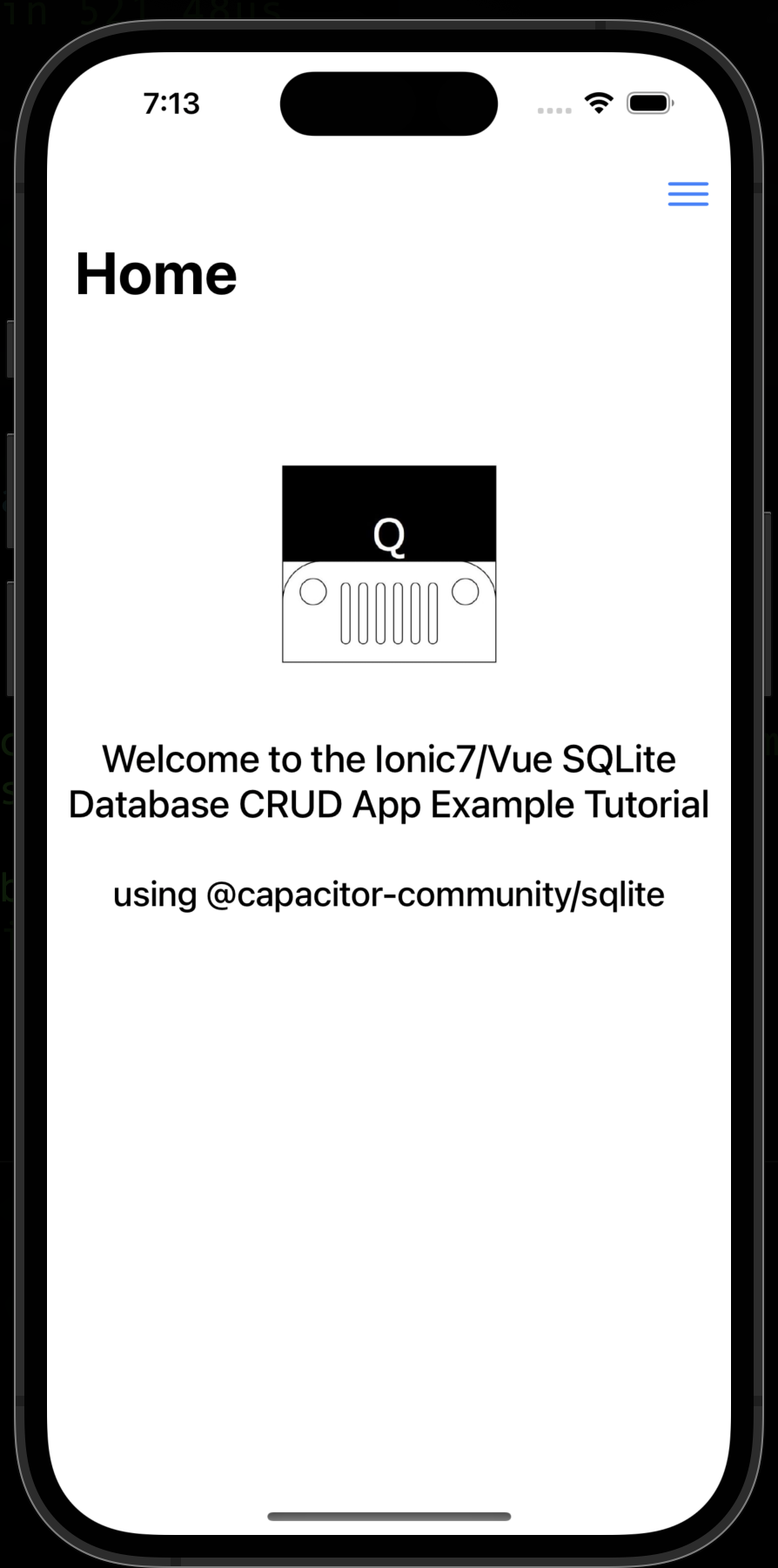
-
To open the menu, click on the
icon in the top left corner. 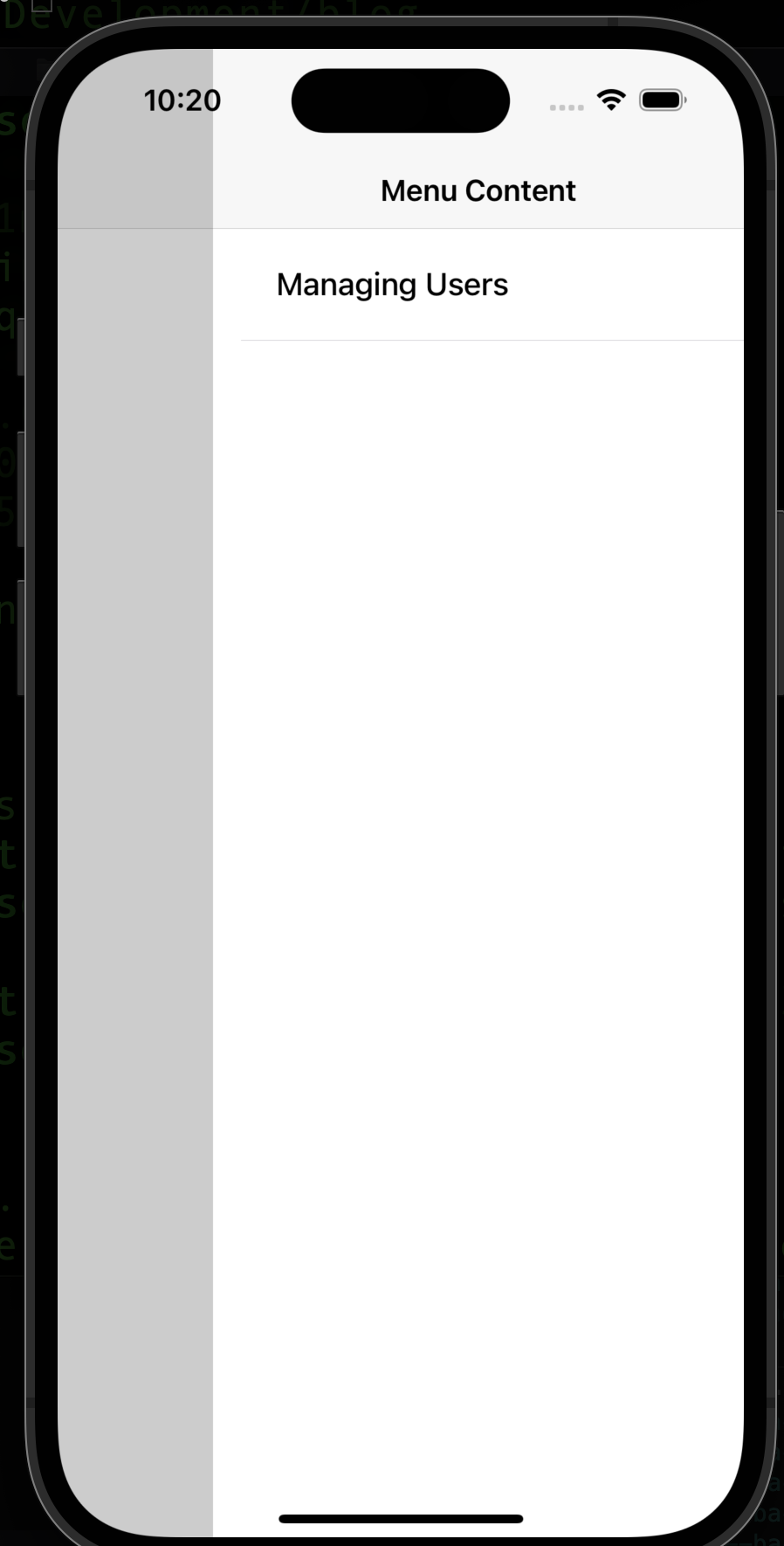
-
In the
Menu Contentclick onMANAGING USERS
On the screen-copies, ones has entered already some users.
- To input new users
- type a new user on the input field “Rose Miller” under Name
- press on the
"Add User"button will add the user.
-
To update the
activevalue for a user, press on the check icon on the left it will toggle the value from 1 to 0 or from 0 to 1. -
To delete a user press on the
trashicon. - To leave the
UsersPageby going backHome.
Run the Android App
-
Run the following command:
npm run android:start -
In Android Studio
- go to the menu Android/Preferences/Build, Execution, Deployment/Build Tools/Gradle and then select the gradle JDK
17 Oracle OpenJDK Version 17.0.7. Then pressApplyandOK. - go to File/Sync Project With Gradle Files.
- go to Build/Clean Project.
- select your Emulator or Physical Device.
- run the app
- go to the menu Android/Preferences/Build, Execution, Deployment/Build Tools/Gradle and then select the gradle JDK
-
Screenshot of the screen for the Home page:

-
To open the menu, click on the
icon in the top left corner. 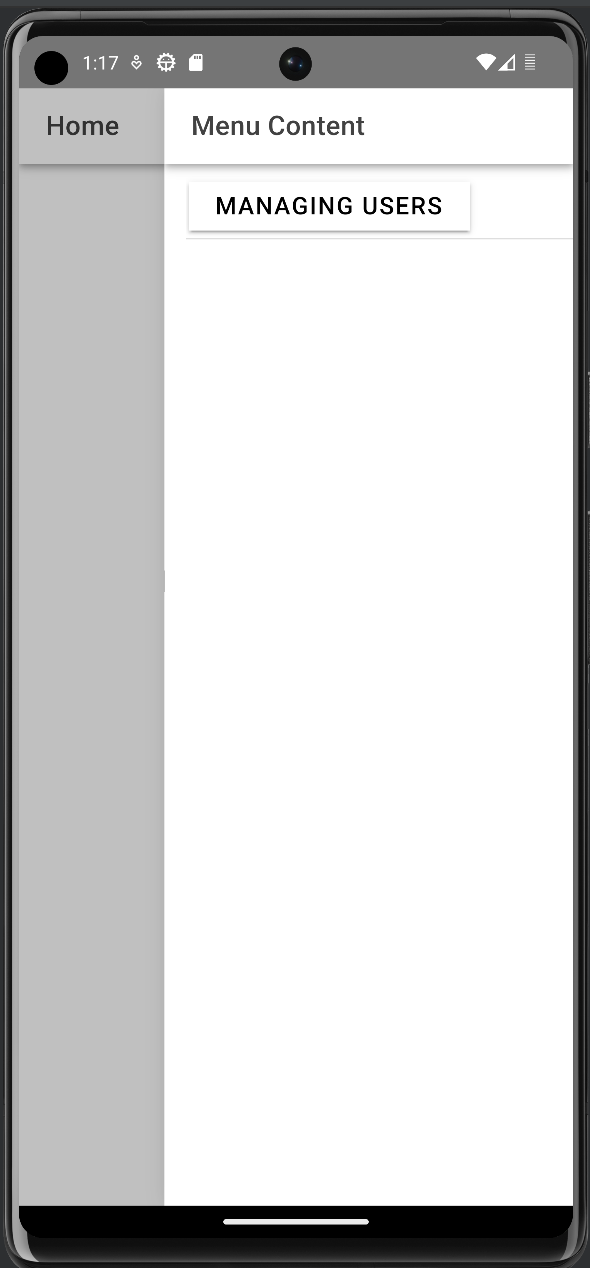
-
In the
Menu Contentclick onMANAGING USERS
On the screen-copies, ones has entered already some users.
- To input new users
- type a new user on the input field “Rose Miller” under Name
- press on the
"Add User"button will add the user.
-
To update the
activevalue for a user, press on the check icon on the left it will toggle the value from 1 to 0 or from 0 to 1. -
To delete a user press on the
trashicon. - To leave the
UsersPageby going backHome.
Run the Electron App
-
Run the following command:
cd electron -
Open the
package.jsonfile and replace the scripts:, dependencies:, devDependencies: sections with:"scripts": { "build": "tsc && electron-rebuild", "electron:start-live": "node ./live-runner.js", "electron:start": "npm run build && electron --inspect=5858 ./", "electron:pack": "npm run build && electron-builder build --dir -c ./electron-builder.config.json", "electron:make": "npm run build && electron-builder build -c ./electron-builder.config.json -p always" }, "dependencies": { "@capacitor-community/electron": "^4.1.2", "@capacitor-community/sqlite": "5.2.3", "better-sqlite3-multiple-ciphers": "^8.4.0", "chokidar": "~3.5.3", "crypto": "^1.0.1", "crypto-js": "^4.1.1", "electron-is-dev": "~2.0.0", "electron-json-storage": "^4.6.0", "electron-serve": "~1.1.0", "electron-unhandled": "~4.0.1", "electron-updater": "~5.0.1", "electron-window-state": "~5.0.3", "jszip": "^3.10.1", "node-fetch": "2.6.7" }, "devDependencies": { "@electron/rebuild": "^3.3.0", "@types/better-sqlite3": "^7.6.4", "@types/crypto-js": "^4.1.1", "@types/electron-json-storage": "^4.5.0", "electron": "^25.2.0", "electron-builder": "^24.6.3", "typescript": "~4.3.5" }, -
In your Editor delete the
node_modulesfolder andpackage-lock.jsonfile. -
Then run the following commands:
npm install cd .. npm run electron:start -
Screenshot of the screen for the Home page:

-
To open the menu, click on the
icon in the top left corner. 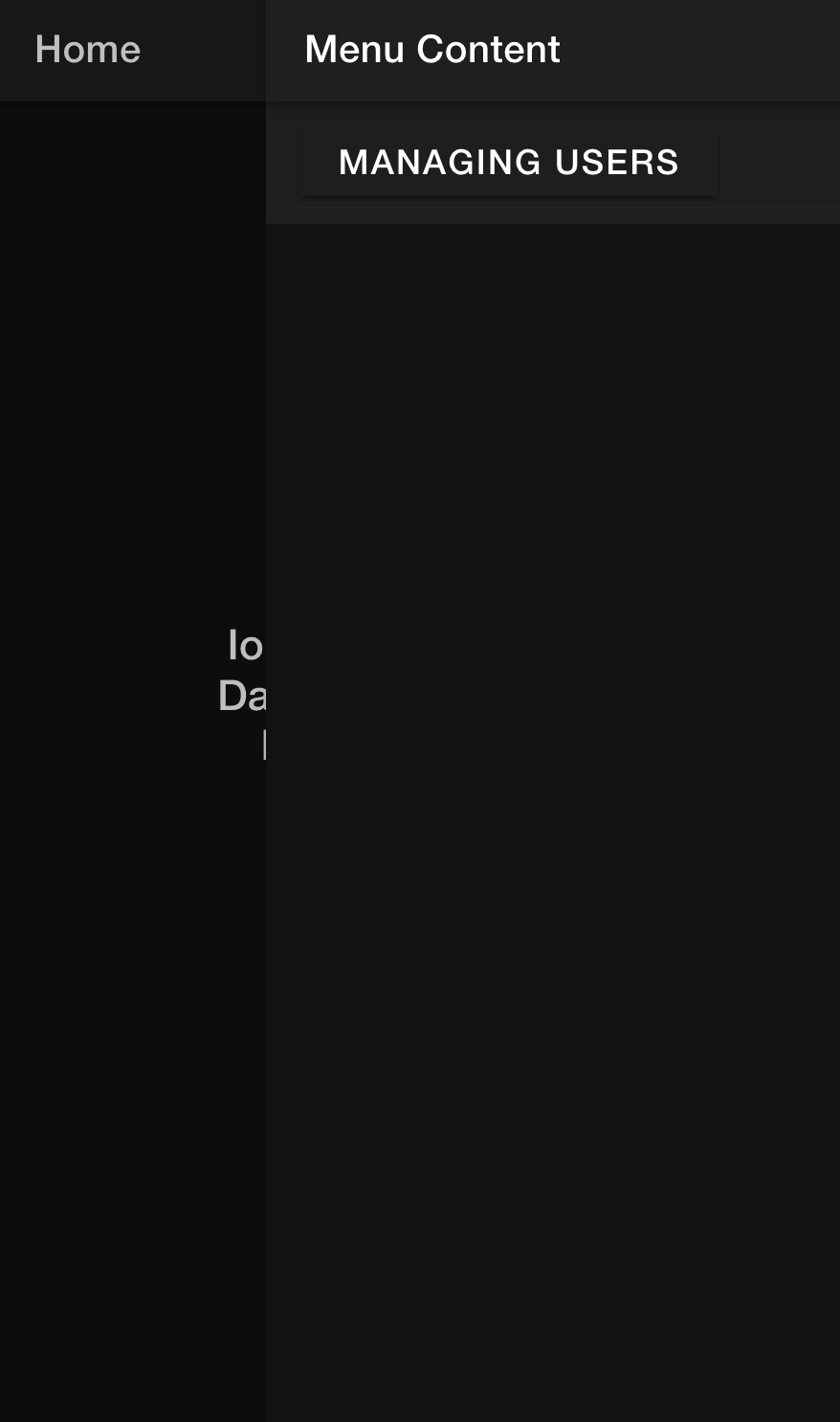
-
In the
Menu Contentclick onMANAGING USERS
On the screen-copies, ones has entered already some users.
- To input new users
- type a new user on the input field “Rose Miller” under Name
- press on the
"Add User"button will add the user.
-
To update the
activevalue for a user, press on the check icon on the left it will toggle the value from 1 to 0 or from 0 to 1. -
To delete a user press on the
trashicon. - To leave the
UsersPageby going backHome.
Part 2 Conclusion
We have completed the Part 2 - Native and Electron applications of the Ionic 7 SQLite Database CRUD App Example Tutorial using Vue framework and @capacitor-community/sqlite.
We have learned to adapt the capacitor.config.tsfile and the modify the scripts: section of the package.jsonfile for native apps
We learned how to build and run the application for each native platforms.
Enjoy your development from there.
